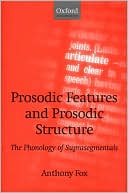

 |

|

The average rating for Prosodic Features and Prosodic Structure: The Phonology of Suprasegmentals based on 2 reviews is 4.5 stars.
Review # 1 was written on 2011-04-05 00:00:00 Michael Fitsimons Michael FitsimonsAs someone without linguistic training, I found this both easy to read and incredibly interesting. Curzan clearly writes for a general audience, translating most OE and ME texts, defining technical terms, though some might find having Google handy to be of help. The book is predominantly a descriptive, historical study, but neither does Curzan shy away from feminist linguistics, which she builds on and contributes to throughout. Written in 2003, it is amazing that the book already reads a little datedly (is culture moving that fast?), with the sexist nature of the gender-inclusive "guys" still under question, for example. There are important anticipations of non-binary language, and I'd love to see how this would have been fleshed out had Curzan written the book today. There is so much to learn from reading this, from some mythbusting about the relationship between grammatical gender (e.g. masculine, feminine, and neuter in German) and natural gender, which is what we (mostly, or increasingly) have in English, where pronoun gender almost exclusively reflects the speaker's ideas about the gender of the referent, rather than reflecting the grammatical category of the noun (the term "gender" in grammatical gender is confusing; it is more like a category that often has little to do with natural gender; some languages, for example, have 20+ "genders", that is, categories that determine how other words relate to the noun in a particular category). Much of Curzan's study reveals that key features of the gender shift (from a grammatical gender system shared with other Germanic languages to a natural gender system found in Modern English) are already apparent in OE. So, pronouns referring back to humans and human-like beings (e.g. the devil) would frequently reflect the gender of the thing referred to, not the gender of the noun. Wifmann (cognate to Mod. E. woman), for example, is a masculine noun but would take feminine pronouns, reflecting the content of the noun rather than the actual word. At this stage, too, inanimate nouns, which are gendered in other Germanic languages, begin to take "it" (OE: hit) as their pronoun, though not overwhelmingly. It is in ME that this trend begins to crystallise. A few nouns, their main feature being frequency, such as sun, moon, month, city, church, are labelled "resilient nouns" as they rarely take "it" but rather have gendered pronouns. Curzan also attends to gendered nouns, like boy, girl, man, woman, and many others, examining their entry into English and their changing meanings over time, sometimes crossing gender boundaries to refer to women instead of men, and vice versa, and often being more pejorative with time (e.g. wench, maid). |
Review # 2 was written on 2014-06-03 00:00:00 E. Suzanne Rowland E. Suzanne RowlandWhoever had the chutzpah to say this is "Readable" is a criminal and belongs in jail. Interesting? Yes! But also a tremendously dry read. I might be the wrong audience, but it takes a lot of effort to tease out at the end of a chapter 'and your conclusion is...?' It's a patently huge survey of gender in English, from the codifying of gendered nouns to gendered connotations and denotations. It's incredibly well-researched. And there's some really fascinating examples given -- I wasn't aware that bomb makers referred to successful bombs as "boys" and failed bombs as "girls," or that "oh boy" might be a lingering reference to the devil. Heck, I wouldn't mind reading some of the Old English text examples all day. For every interesting detail, though, there's a stack of quotes, technical terms that make my eyes bleed, and winding complex arguments that leave me none the wiser. It feels like this book is a big accomplishment, but I'm just happy it's over. She makes a lot of good points (the evolution of gender in words is complex, and a word's gendered history isn't always clear cut). Maybe her most interesting point she brings up is now that English is so standardized now and we have ready access to how it's codified, its growth and history is under new and powerful forces (dictionaries in an of themselves are a force on the meaning of words). I don't know if her final chapter on how to approach reform really provides anything clear cut, but there sure is a lot of food for thought. |
CAN'T FIND WHAT YOU'RE LOOKING FOR? CLICK HERE!!!